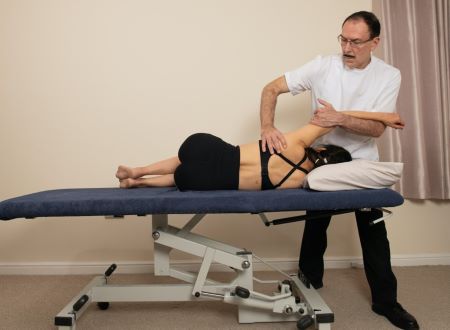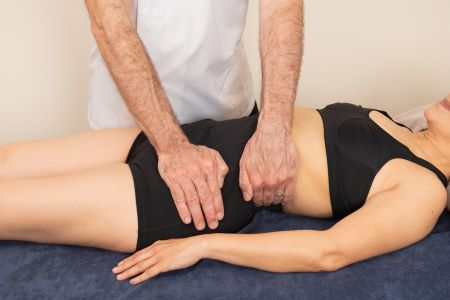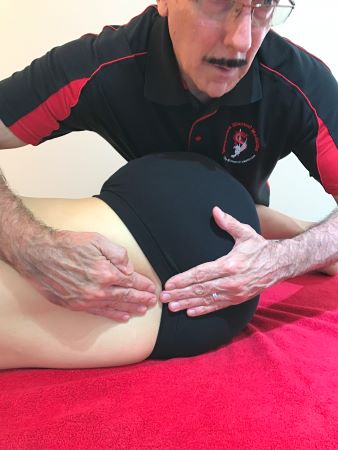Joint mobilisation is a manual medicine technique applied by the practitioner to improve joint mobility and relieve pain. It involves the passive movements of a joint to restore or enhance its range of movement, along with relaxing shortened muscles that cross the joint.

Types of Joint Mobilisation
Of the 2 main types of joint mobilisation, we are looking at the theories of Geoffrey Maitland, an Australian physiotherapist and Freddy Kaltenborn, a Norwegian physical educator and later as a physiotherapist subsequently studied orthopaedic medicine in London. Followed by Chiropractic in Germany & Osteopathy in the UK.
Brief History of Joint Mobilisation
Both practitioners developed their techniques during the 1940s and 50s which have essentially evolved from osteopathic articulation (1890 or earlier), whereby joints are put through ranges of motion in a graded fashion with the goal of enhancing the quality and quantity of motion. These were taught in most osteopathic colleges, especially the British School of Osteopathy by Alan Stoddard DO, this is where Kaltenborn (who studied under Alan Stoddard), learnt the application of joint articulation, later to become Kaltenborn mobilisation.
These procedures are extensions of the diagnostic process of evaluating joint movement. If a restriction of motion is encountered in one direction, the practitioner delivers a series of gentle rhythmic movements in the direction of motion restriction. This greatly increases the joint range of movement along with stimulating the flow of blood to the joint and surrounding tissues. When appropriately applied to conditions like osteoarthritis they can help ease pain and improve joint function.

Benefits of Joint Mobilisation
There are many benefits to the patient, when joint mobilisation is carried out, it improves muscle function around the joint. If a joint has an improved mechanical function the muscle tissue does not over work to provide motion and is therefore less likely to become strained and painful. By improving joint mechanics and restoring range of movement overall patient mobility is increased. This assists circulation and helps to disperse inflammatory exudate, taking pressure off the local sensory nerve endings which reduces pain sensitivity, enhancing overall pain relief for the patient. From this improved function the recipient notes better walking, standing, spinal flexibility and shoulder-arm usage. Although effects may be temporary, they should be accompanied by mobility exercises.

Common musculoskeletal issues that benefit from mobilisation include:
- Occipital neuralgia
- Cervical spondyloarthrosis
- TMJ dysfunction
- Adhesive capsulitis (frozen shoulder)
- Elbow joint dysfunction
- Wrist and carpal tunnel syndrome
- Rib dysfunction and breathing issues
- Lumbar spondyloarthrosis
- Hip and Knee osteoarthritis
- Ankle and foot stiffness
Contraindication
Joint mobilisation can be an effective technique for patient with stiff and painful joints. However, it is not the correct approach for everyone, especially patients with:
- Osteoporosis
- Connective tissue disorders where the joints move too much i.e. Ehlers Danlos
- Fractures and bone cysts
- Tumours within a joint
- Fused joints
- Infection within a joint
- Severe inflammatory arthritis i.e. Rheumatoid Arthritis
- Prolapsed intervertebral discs
- Patients on blood thinners
- Neuropathy i.e. Charcot Marie Diabetic

Joint mobilisation stands as a cornerstone technique in manual medicine, championed by pioneers like Geoffrey Maitland and Freddy Kaltenborn. Rooted in osteopathic principles, this therapeutic approach offers a spectrum of benefits, from enhancing joint mobility and muscle function to relieving pain and improving overall mobility. While its efficacy spans across various musculoskeletal conditions, careful consideration of contraindications is paramount to ensure patient safety and optimal outcomes. With its rich history and tangible benefits, joint mobilisation remains a valuable tool in the hands of skilled practitioners like ourselves, dedicated to enhancing the well-being of our patients.
References
- Stoddard, A. (1980) Manual of Osteopathic Technique, Rev (Ed), HarperCollins, London.
- Elazar AH, Elmonayeri M. Inflammation. The Pathophysiologic Basis of Nuclear Medicine. 2014 Jun 27:69–98. doi: 10.1007/978-3-319-06112-2_4. PMCID: PMC7123337.
- Do Moon G, Lim JY, Kim DY, Kim TH. Comparison of Maitland and Kaltenborn mobilization techniques for improving shoulder pain and range of motion in frozen shoulders. J Phys Ther Sci. 2015 May;27(5):1391-5. doi: 10.1589/jpts.27.1391. Epub 2015 May 26. PMID: 26157227; PMCID: PMC4483405.
- Agarwal S, Raza S, Moiz JA, Anwer S, Alghadir AH. Effects of two different mobilization techniques on pain, range of motion and functional disability in patients with adhesive capsulitis: a comparative study. J Phys Ther Sci. 2016 Dec;28(12):3342-3349. doi: 10.1589/jpts.28.3342. Epub 2016 Dec 27. PMID: 28174448; PMCID: PMC5276757.
- Bailey E, Heneghan NR, Cassidy NJ, Falla D, Rushton AB. Clinical effectiveness of manipulation and mobilisation interventions for the treatment of non-specific neck pain: protocol for a systematic review and meta-analysis. BMJ Open. 2020 Oct 10;10(10): e037783. doi: 10.1136/bmjopen-2020-037783. PMID: 33040001; PMCID: PMC7549443.
- Pozsgai M, Péter IA, Farkas N, Than P, Nusser N. End-range Maitland mobilization decreasing pain sensitivity in knee osteoarthritis: randomized, controlled clinical trial. Eur J Phys Rehabil Med. 2022 Jun;58(3):442-451. doi: 10.23736/S1973-9087.22.06680-1. Epub 2022 Jan 5. PMID: 34985236; PMCID: PMC9980501.
- DOI: http://dx.doi.org/10.24018/ejmed.2021.3.5.1050
- https://www.jospt.org/doi/abs/10.2519/jospt.1980.1.4.214
- https://www.sciencedirect.com/science/article/abs/pii/S0161475418300125
- https://www.sciencedirect.com/science/article/abs/pii/S2468781219302103
Main – Photo by Mathew Schwartz on Unsplash



